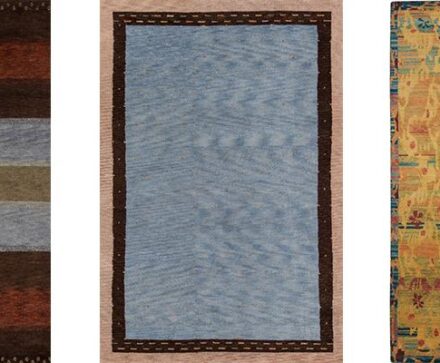Traditional Rug-dyeing Techniques: Vegetable-dyed & Hand Card and Spin
Vegetable-dyed rugs and hand card and spun rugs can be very unique. Learn more about these traditional techniques to create a rug and how you can get a beautiful piece that is one of a kind.
John: Welcome to The Rug Gallery with Sam Presnell. The Rug Gallery is an oriental rug company and carpet store in Cincinnati, Ohio. I’m John Maher and I’m here with the owner of The Rug Gallery, Sam Presnell. Hi, Sam.
Sam: Hi, John.
John: Sam, we’re talking today about vegetable dyed rugs and hand card and spin. What is veg dye and what does it mean for rugs?
What Are Vegetable Dyed Rugs?
Sam: Basically, what we’re using is vegetable matter — natural matter to extract color from in order to dye the rug or carpet. You will get a product that basically is inconsistent. One of the things about veg dye is it’s very, very tough to consistently make the same rug over and over again. If you are making a program, you probably won’t make it from veg dye because you’re not going to be able to consistently get that same color time after time.
John: What do you mean when you say when you are making a program?
Sam: A program would be a rug you are making in several sizes and you’re making it over a long period of time. Maybe you’re selling online and it comes in five sizes and you’re going to order any one of those sizes. You are constantly expecting that rug to look just like the original rug you took a picture of and consistently turn out to what we call a program rug that just basically gets made over and over again. You’ve got to really control that color. I mean, that’s the key, because people don’t want to find that it’s not the color that it’s supposed to be.
John: Right.
Sam: It’s different.
What is Hand Card and Spin?
John: Then what about hand card and spin? What does that mean?
Sam: Hand card means that their use is low paddles, I would say. It looks like a big doggy brush and basically what they’re doing is they are taking the raw wool and they’re just brushing up between two paddles with these little needles on it. What they are doing is they are straightening that wool out. Now there are machines that you can install that will straighten that wool out as well, but hand carding puts a little bit more of a twist to the yarn. It’s not quite as stretched and tends to give lot more irregularities to it.
The same thing hand spinning; you’re not getting a very consistent spin to it. If you are pulling hard back while you’re wringing the hand spinning and you’re pulling back on that hank of raw wool, it will get tighter. Then if you loosen up a little bit to let it come up, it will get thicker. You see a very irregular fiber basically, that would have thin spots and heavier spots.
A lot of people say, “Wow, why did you want that?” I think if you like texture in a rug, that’s why you would like that. Or, if you want what I call inconsistency in color, where you see those depths of color coming through. Where it’s less spun, it will absorb dye in a much deeper and darker way and the thinner, tighter spun spots will accept that dye a lot softer and lighter. You’re getting those great subtleties of coloring into a hand spun, veg dyed piece that you’re not going to produce by any manmade means. I think [that] is more the way the rugs were made originally, and more an art form, [being] less mechanical and less consistent.
Quality of Vegetable Dyed Rugs and Hand Card and Spun Rugs
John: Right. So are these techniques that have been used for hundreds of years and are older, more traditional techniques for making a rug? Are rugs that use these type of techniques better quality?
Sam: Yes. Most people want to pay for that because what happens when you hand spin a rug, it probably takes, goodness gracious, two to three time longer. Let’s say as long to weave the rug as it would just to spin the wool. I mean, it seems insane, but that’s true and you can imagine extracting color out of plant materials, barks and flowers, bugs and all kinds of natural things [that produce color.] It’s such a painstaking operation compared to buying a color just on a spoon and throwing it into a pot and getting color.
It is very expensive to produce a hand spun, veg dyed rug. I would say you can usually expect to pay about double for a hand spun veg dyed piece as compared to something that’s machine done. There won’t be difference in quality. There won’t be difference in look basically unless you look hard at it. A lot of people just won’t spend that for it because they don’t see that little subtle differences that I think some people prefer, like me.
John: Right. It’s more in knowing that you have a unique rug that’s not exactly like any other rug that’s out there, because of all of these little inconsistencies like you said — things that set your rug apart from the other ones.
Sam: Right. You are not going to use it in any machine made piece because you can’t get consistency in it. You’re not going to use it in any carpet because you can’t get the consistency of color. You’re going to see it more in [the] high end type of pieces and tribal pieces and things like that, which is more expensive to find in the first place. A lot of times, there’s different dying techniques that try to, what I call, fool it or mark it to look like it is hand spun and veg-dyed. They have different techniques, different ways of spinning, over twisting fibers and then dying it and then trying to untwist it so it accepts the color differently and it gives you that hands-spun veg-dyed look. But there really is a dramatic difference in my eyes between the pieces, but most people probably wouldn’t care or know the difference.
How to Spot Vegetable Dyed Rugs and Hand Card and Spun Rugs
John: Okay. And, how can I tell if I’m getting a rug that uses these techniques?
Sam: Again, those little small things. You have to look at the inconsistency in the wool, their thinness and thickness. You can see and feel it in some cases. So, if you just peel back the fiber and look back into the knots and into the yarns, you’ll see the inconsistency in the yarn. If you see it very twisted and everything is at the perfect twist, I can almost guarantee that’s machine done. If you see a lot of inconsistency in that spin and very hard to see the spin, it’s probably a hand-spun. And then when you see those subtleties of what I call just slight total differences of depth of color into those designs, you’ll know it’s a big difference from something that was not like that and something was done by the hand.
Most times, I say leave it to the experts. They should be able to show it to you, but at the same time, that can be developed. If you touch enough and buy enough, you’ll start picking up on what I’m telling you.
John: All right. That’s great information, Sam. Thanks again for speaking with me today.
Sam: All right, John, always my pleasure. Thank you.
John: And for more information about Sam, The Rug Gallery and Oriental rugs and carpets visit ruggallerycincy.com or call 513-793-95-05 and make sure you catch the latest episodes by subscribing to this podcast on iTunes. And we would appreciate it if you can give us a review on iTunes as well. I’m John Maher. See you next time on The Rug Gallery.


